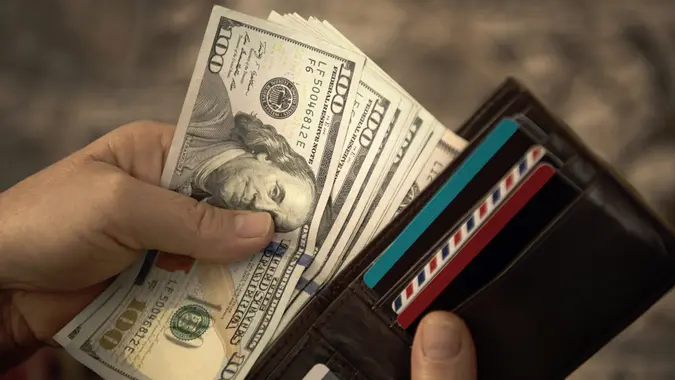What Is the Energy Efficient Home Improvement Credit?

Commitment to Our Readers
GOBankingRates' editorial team is committed to bringing you unbiased reviews and information. We use data-driven methodologies to evaluate financial products and services - our reviews and ratings are not influenced by advertisers. You can read more about our editorial guidelines and our products and services review methodology.

20 Years
Helping You Live Richer

Reviewed
by Experts

Trusted by
Millions of Readers
If you’re making eco-friendly home upgrades in 2024, you could qualify for up to $3,200 in non-refundable tax credits. This article explains which projects qualify, how to claim the Energy Efficient Home Improvement Credit, and how to get the maximum benefit — including for heat pumps, windows, insulation, and energy audits.
Who Qualifies for the Credit
To be eligible for the Energy Efficient Home Improvement Credit, the qualified improvements you make must be made at your primary U.S. residence. Your home can’t be a new build, and it must not be used for business purposes more than 20% of the time. If you use it for business purposes more than 20% of the time, you’ll get a reduced credit.
How To Claim the Energy Efficient Home Improvement Credit
To claim the Energy Efficient Home Improvement Credit on your tax return, here’s what you need to do:
- Gather paperwork: Depending on the upgrade you are claiming, there are paperwork requirements. You’ll need your purchase receipt and Energy Star information for certain upgrades, or written proof of the eligibility of the item purchased.
- Complete IRS Form 5695: To claim the credit, you’ll need to complete IRS Form 5695. This form allows you to list the amounts for qualifying home upgrades, and calculate the amount of the credit itself. There are several pages of inputs and qualifying questions to answer to help you claim the right amount.
- Attach Form 5695 and paperwork to the tax return: When you submit your tax return, you’ll need to attach the required paperwork and Form 5695 to your return to claim the credit.
- Use tax software: Most modern tax software will allow you to input the information and will automatically fill out the required forms to claim the Energy Efficient Home Improvement Credit. This makes it easier than doing things by hand and can instantly calculate how much you qualify for.
How Much Can You Save?
The credit allows you to claim up to 30% of qualifying expenses, including installation charges. The maximum credits include:
| Upgrade Type | Max Credit |
| Heat pumps, biomass boilers or stoves | Up to $2,000 |
| Exterior doors | $250 per door, up to $500 total |
| Windows or skylights | Up to $600 |
| Energy audit | Up to $150 |
| Insulation or air sealing materials | Up to $1,200 |
| A/C, water heaters, boilers | Up to $600 |
| Maximum yearly credit | $3,200 total |
What Upgrades Are Eligible?
Not all energy-efficient improvements qualify for the tax credit. Here are the upgrades that do.
Windows, Doors and Skylights
You can get a tax credit for windows and doors — $250 per door (up to $500 total), and up to $600 for windows or skylights. Keep in mind that they all must meet Energy Star requirements.
HVAC Systems, Water Heaters and Boilers
Certain air conditioners, water heaters, boilers and furnaces may qualify for up to $600 per item. These systems must meet or exceed the Consortium for Energy Efficiency’s highest efficiency tier set at the beginning of the calendar year.
There’s also a $2,000 credit for heat pumps, heat pump water heaters and biomass stoves and boilers that meet or exceed the CEE highest efficiency tier and operate at a thermal efficiency rating of at least 75%.
Insulation and Air Sealing
You can get up to $1,200 in tax credits for qualifying insulation and air-sealing material upgrades that meet the International Energy Conservation Code standards. Since these standards are updated regularly, the materials must meet the latest standard two years prior to the calendar year the materials were installed.
Energy Audits
If you pay for a home energy audit, you can get up to $150 in tax credits. The audit must include a written report and be performed by a certified home energy auditor. Qualifications can be found on the Department of Energy website.
How Much Can You Save With the Credit
| Energy-Efficient Upgrade | Maximum Credit |
| Heat pumps, biomass boilers or stoves | Up to $2,000 |
| Exterior doors | $250 per exterior door — up to $500 total |
| Windows or skylights | Up to $600 |
| Energy audit | Up to $150 |
| Insulation or air sealing materials | Up to $1,200 |
| Air conditioners, water heaters, and boilers | Up to $600 |
Tips to Maximize Your Energy Tax Credit
Improving your home could help you save thousands of dollars on your income taxes. But it’s important to do your research before making any eco-friendly purchase so you’re taking full advantage of the tax incentives and rebates. Here are a few tips for maximizing your tax savings while upgrading your home.
How to Claim the Credit
- Gather receipts, installation documents, and Energy Star or CEE certification paperwork
- Complete IRS Form 5695
- Attach Form 5695 and supporting documents to your Form 1040
- File your return or submit through tax software
- Keep records for your tax files in case of audit
What to Know About the Energy-Efficient Home Improvement Credit
- The credit covers up to 30% of qualified home upgrades, with a max of $3,200 per year
- Eligible improvements include heat pumps, windows, insulation, doors, and energy audits
- Products must meet Energy Star or CEE efficiency standards
- Use Form 5695 and attach it to your federal tax return
- Make all upgrades in the same calendar year to maximize your credit
Our in-house research team and on-site financial experts work together to create content that’s accurate, impartial, and up to date. We fact-check every single statistic, quote and fact using trusted primary resources to make sure the information we provide is correct. You can learn more about GOBankingRates’ processes and standards in our editorial policy.
- IRS. 2024. "Energy Efficient Home Improvement Credit."
 Written by
Written by  Edited by
Edited by 

























